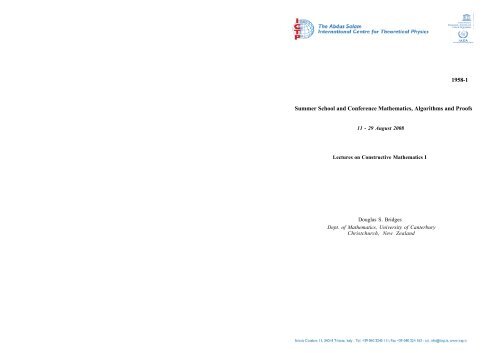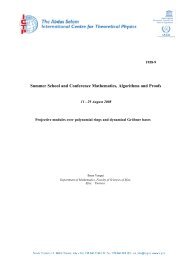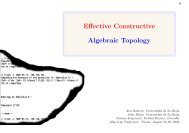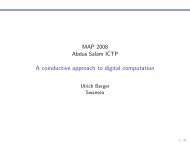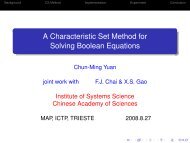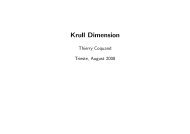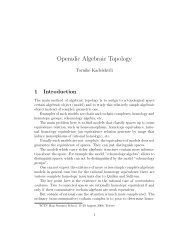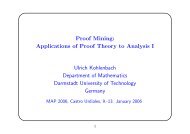Lectures on Constructive Mathematics. - Mathematics, Algorithms ...
Lectures on Constructive Mathematics. - Mathematics, Algorithms ...
Lectures on Constructive Mathematics. - Mathematics, Algorithms ...
You also want an ePaper? Increase the reach of your titles
YUMPU automatically turns print PDFs into web optimized ePapers that Google loves.
1958-1<br />
Summer School and C<strong>on</strong>ference <strong>Mathematics</strong>, <strong>Algorithms</strong> and Proofs<br />
11 - 29 August 2008<br />
<str<strong>on</strong>g>Lectures</str<strong>on</strong>g> <strong>on</strong> C<strong>on</strong>structive <strong>Mathematics</strong> I<br />
Douglas S. Bridges<br />
Dept. of <strong>Mathematics</strong>, University of Canterbury<br />
Christchurch, New Zealand
<str<strong>on</strong>g>Lectures</str<strong>on</strong>g> <strong>on</strong> C<strong>on</strong>structive <strong>Mathematics</strong><br />
Douglas S. Bridges<br />
Department of <strong>Mathematics</strong> & Statistics,<br />
University of Canterbury,<br />
Christchurch, New Zealand
Lecture 1
C<strong>on</strong>structive vs n<strong>on</strong>c<strong>on</strong>structive<br />
N<strong>on</strong>c<strong>on</strong>structive proof: an existence proof-by-c<strong>on</strong>tracti<strong>on</strong> of this schematic<br />
form:<br />
Suppose that the desired object x does not exist.<br />
Derive a c<strong>on</strong>tradicti<strong>on</strong>.<br />
Claim that x must exist after all.<br />
This proves that it is impossible for x not to exist; but it does not tell us how<br />
to …nd/compute/c<strong>on</strong>struct x:<br />
“[N<strong>on</strong>c<strong>on</strong>structive existence proofs] inform the world that a treasure<br />
exists without disclosing its locati<strong>on</strong>.” Hermann Weyl
C<strong>on</strong>structive proof of the existence of an object x: a proof that embodies an<br />
algorithm for the c<strong>on</strong>structi<strong>on</strong>/computati<strong>on</strong> of the desired object x.<br />
Note: Not all proofs-by-c<strong>on</strong>tradicti<strong>on</strong> are n<strong>on</strong>c<strong>on</strong>structive. it is perfectly c<strong>on</strong>structive<br />
to prove P false by assuming that P is true and deriving a c<strong>on</strong>tradicti<strong>on</strong>.<br />
This process just captures the c<strong>on</strong>structive meaning of negati<strong>on</strong>.
A n<strong>on</strong>c<strong>on</strong>structive proof:<br />
There exists a digit that appears in…nitely often in the decimal expansi<strong>on</strong> of<br />
the number :<br />
Note …rst that the decimal expansi<strong>on</strong> of is n<strong>on</strong>terminating and<br />
n<strong>on</strong>recurring, since is irrati<strong>on</strong>al.<br />
Suppose that each of the digits 0; 1; 2; : : : ; 9 occurs <strong>on</strong>ly …nitely many<br />
times in the decimal expansi<strong>on</strong> of :<br />
Then there exists a positive integer N such that each of 0; 1; 2; : : : ; 9<br />
appears at most N times in the decimal expansi<strong>on</strong> of :<br />
So that decimal expansi<strong>on</strong> cannot have more than 10N places, which<br />
c<strong>on</strong>tradicts the “Note …rst ...” above.
Although the decimal expansi<strong>on</strong> of has been computed to billi<strong>on</strong>s of places,<br />
the foregoing proof does not tell us (and nobody knows) which of the digits<br />
0; 1; 2; : : : ; 9 appears in…nitely often in the n<strong>on</strong>terminating, n<strong>on</strong>recurring<br />
expansi<strong>on</strong>.<br />
All we know is that it is impossible that each of the ten digits appears <strong>on</strong>ly a<br />
…nite number of times.
For another n<strong>on</strong>c<strong>on</strong>structive proof, c<strong>on</strong>sider the statement:<br />
There exist irrati<strong>on</strong>al numbers a; b such that a b is rati<strong>on</strong>al.<br />
Either p p<br />
2<br />
2 is rati<strong>on</strong>al or it is irrati<strong>on</strong>al.<br />
In the …rst case, take a = b = p 2:<br />
In the sec<strong>on</strong>d case, take a = p p<br />
2<br />
2<br />
and b = p 2:
Why is this proof n<strong>on</strong>c<strong>on</strong>structive?<br />
1) It does not tell us which of the two alternatives for p p<br />
2<br />
2 (rati<strong>on</strong>al or<br />
irrati<strong>on</strong>al) actually holds.<br />
2) It therefore does not tell us which of the two choices for a and b actually<br />
produces irrati<strong>on</strong>al numbers with the desired property.<br />
A c<strong>on</strong>structive proof would produce, unambiguously, two irrati<strong>on</strong>al numbers a<br />
and b and show us that a b is rati<strong>on</strong>al.<br />
Explicit example of irrati<strong>on</strong>al numbers a; b such that a b is rati<strong>on</strong>al:<br />
a = p 2; b = log 2 9; a b = 3:
In fact, p p<br />
2<br />
2 is transcendental, by the (classical) Gelfand-Schneider theorem:<br />
a b is transcendental if (i) a is algebraic, (ii) a 6= 0; 1 and (iii) b is<br />
both algebraic and irrati<strong>on</strong>al.
If we want to prove something c<strong>on</strong>structively, then we must not use the law of<br />
excluded middle,<br />
LEM: For any propositi<strong>on</strong> P , either P is true or else P is false.<br />
Allowing the use of LEM is tantamount to allowing n<strong>on</strong>c<strong>on</strong>structive existence<br />
proofs.
Historical note: Existence proofs-by-c<strong>on</strong>tradicti<strong>on</strong> go back at least as far as<br />
Gauss (Fundamental Theorem of Algebra, 1799).<br />
They became dominant after Hilbert’s proof of his “basis theorem” (1888).<br />
“Das ist nicht Mathematik. Das ist Theologie.” Paul Gordan
The c<strong>on</strong>structive vs n<strong>on</strong>c<strong>on</strong>structive c<strong>on</strong>troversy goes back at least to Kr<strong>on</strong>ecker’s<br />
attacks <strong>on</strong> Cantor’s set theory (1877–).<br />
It was strengthened by Brouwer’s campaign, from 1907 <strong>on</strong>wards, to c<strong>on</strong>vert all<br />
mathematicians to the exclusive use of c<strong>on</strong>structive methods, and culminated<br />
in the Grundlagenstreit between Brouwer and Hilbert in the 1920s.<br />
“Taking the principle of excluded middle from the mathematician<br />
would be the same, say, as proscribing the telescope to the astr<strong>on</strong>omer<br />
or to the boxer the use of his …sts.” David Hilbert (1928)
What is c<strong>on</strong>structive mathematics?<br />
Two ways to approach computability in mathematics:<br />
1. Use classical logic:<br />
– allows “decisi<strong>on</strong>s” that cannot be made by any real computer<br />
– requires clearly speci…ed types of algorithm<br />
2. Use intuiti<strong>on</strong>istic logic:<br />
– automatically takes care of the problem of n<strong>on</strong>computati<strong>on</strong>al “decisi<strong>on</strong>s”<br />
– enables us to work, with any mathematical objects, in the familiar style<br />
of the analyst, algebraist, geometer, ...
Bishop-style c<strong>on</strong>structive mathematics (BISH) is just<br />
mathematics with intuiti<strong>on</strong>istic logic<br />
and some appropriate set-theoretic foundati<strong>on</strong> such as the CST of Myhill,<br />
Aczel, and Rathjen.
Using intuiti<strong>on</strong>istic logic, we can<br />
— clarify distincti<strong>on</strong>s of meaning obscured by classical logic, and<br />
— allow results to have a wider range of interpretati<strong>on</strong>s (including recursive<br />
<strong>on</strong>es) than their counterparts proved with classical logic.<br />
“Intuiti<strong>on</strong>istic logic is richer than classical logic, since the former<br />
makes distincti<strong>on</strong>s that the latter fails to make.”<br />
J.L. Bell & M. Machover
We<br />
do not restrict to a class of “c<strong>on</strong>structive/computable objects”;<br />
use intuiti<strong>on</strong>istic logic to deal with the normal objects of mathematics.
Ishihara’s classi…cati<strong>on</strong>:<br />
B a c<strong>on</strong>structive theory of real numbers: the usual R studied with intuiti<strong>on</strong>istic<br />
logic.<br />
B a theory of c<strong>on</strong>structive real numbers: the recursive reals studied with<br />
classical logic.<br />
B a c<strong>on</strong>structive theory of c<strong>on</strong>structive real numbers: the recursive reals<br />
studied with intuiti<strong>on</strong>istic logic.
The BHK interpretati<strong>on</strong><br />
Modern intuiti<strong>on</strong>istic logic is based <strong>on</strong> the BHK-interpretati<strong>on</strong> of the c<strong>on</strong>nectives<br />
and quanti…ers<br />
_ (or); ^ (and); ! (implies); : (not)<br />
9 (there exists), 8 (for all/each).<br />
Note that it is provability, rather than an a priori noti<strong>on</strong> of truth, that is<br />
fundamental to the c<strong>on</strong>structive approach.<br />
Brouwer-Heyting-Kolmogorov
I P _ Q : either we have a proof of P or else we have a proof of Q:<br />
I P ^ Q : we have both a proof of P and a proof of Q:<br />
I P ! Q : by means of an algorithm we can c<strong>on</strong>vert any proof of P into<br />
a proof of Q:<br />
I :P : assuming P; we can derive a c<strong>on</strong>tradicti<strong>on</strong> (such as 0 = 1); equivalently,<br />
we can prove (P ! (0 = 1)) :
I 9xP (x) : we have (i) an algorithm which computes a certain object x; and<br />
(ii) an algorithm which, using the informati<strong>on</strong> supplied by the applicati<strong>on</strong><br />
of algorithm (i), dem<strong>on</strong>strates that P (x) holds.<br />
I 8 x2AP (x) : we have an algorithm which, applied to an object x and a<br />
proof that x 2 A; dem<strong>on</strong>strates that P (x) holds.<br />
Note that in the interpretati<strong>on</strong> of the statement 8 x2AP (x); the proof of P (x)<br />
will normally use both the data describing the object x and the informati<strong>on</strong><br />
supplied by a proof that x bel<strong>on</strong>gs to the set A:
C<strong>on</strong>sider the statement:<br />
LPO For each binary sequence a (an) n>1 either an = 0 for all n; or<br />
else there exists N such that a N = 1:<br />
This is trivially true under classical logic.<br />
What is its BHK interpretati<strong>on</strong>?<br />
We have an algorithm which, applied to any binary sequence a, either<br />
produces a proof that an = 0 for each n; or else computes N such<br />
that a N = 1:<br />
Claim: Such an algorithm is unlikely to be found.
The Goldbach c<strong>on</strong>jecture (GC, 1742):<br />
Every even integer > 2 is a sum of two primes.<br />
Status still unknown.<br />
De…ne a binary sequence a as follows.<br />
If 2n + 2 is a sum of two primes, set an = 0:<br />
If there exists k 6 n such that 2k +2 is not a sum of two primes, set an = 1:
Suppose we have an algorithm as in the BHK interpretati<strong>on</strong> of LPO. Applied<br />
to this binary sequence, this algorithm<br />
either proves that an = 0 for all n (i.e., proves GC)<br />
or else computes N such that a N = 1 (i.e., gives a counterexample to GC).
The use of GC here is purely illustrative: we could have used any of a multitude<br />
of unsolved problems of a certain type (Riemann hypothesis, ...).<br />
C<strong>on</strong>clusi<strong>on</strong>: the existence of an algorithm as in the BHK interpretati<strong>on</strong> of LPO<br />
is highly doubtful.<br />
Moreover, LPO is provably false in certain models of c<strong>on</strong>structive mathematics<br />
(but it is not provably false in Bishop-style c<strong>on</strong>structive mathematics).<br />
We therefore stay clear of LPO as a working c<strong>on</strong>structive principle.
C<strong>on</strong>sequence: we also must avoid using any propositi<strong>on</strong> that c<strong>on</strong>structively<br />
implies LPO.<br />
In particular, we must avoid using the full law of excluded middle.<br />
This has a serious impact <strong>on</strong> even elementary analysis.<br />
C<strong>on</strong>sider the classically trivial propositi<strong>on</strong>:<br />
where<br />
8 x2R (x = 0 _ x 6= 0) ;<br />
x 6= 0 , 9 n2N jxj > 2 n :
Suppose we have a c<strong>on</strong>structive proof— that is, an algorithm which, applied to<br />
any real number x either proves that x = 0 or else computes a positive integer<br />
N such that jxj > 2 N :<br />
Given a binary sequence a; apply this algorithm to the real number<br />
x =<br />
1X<br />
n=1<br />
2 n an = 0 a1a2a3 : : : (in…nite binary expansi<strong>on</strong>).<br />
The algorithm either proves that x = 0; and therefore an = 0 for all n; or<br />
else computes N such that jxj > 2 N :<br />
In the sec<strong>on</strong>d case, an = 0 for all n > N; so, by testing a1; a2; : : : ; a N (a<br />
…nite test), we can check whether an = 0 for all n or there exists n 6 N with<br />
an = 1:
Thus the propositi<strong>on</strong><br />
8 x2R (x = 0 _ x 6= 0)<br />
implies LPO and is therefore essentially n<strong>on</strong>c<strong>on</strong>structive!
Here is another essentially n<strong>on</strong>c<strong>on</strong>structive principle that is trivially true under<br />
classical logic.<br />
LLPO For each binary sequence a with at most <strong>on</strong>e term equal to 1; either<br />
an = 0 for all even n; or else an = 0 for all odd n:<br />
BHK-interpretati<strong>on</strong>:<br />
We have an algorithm which, applied to any binary sequence a and<br />
the data that an = 1 for at most <strong>on</strong>e n; either proves that all evenindexed<br />
terms of the sequence are 0; or else proves that all oddindexed<br />
terms are 0:
Again, it is extremely unlikely that such an algorithm could be produced.<br />
Moreover, LLPO, like LPO, is provably false in certain models of c<strong>on</strong>structive<br />
mathematics (but it is not provably false in BISH).<br />
We therefore avoid using LLPO as a working c<strong>on</strong>structive principle.<br />
Note that LLPO is a c<strong>on</strong>sequence of LPO; but LPO cannot be derived from<br />
LLPO.
C<strong>on</strong>sider the classically trivial propositi<strong>on</strong>: For each real number x; either x > 0<br />
or x 6 0:<br />
Suppose we have a c<strong>on</strong>structive proof: that is, an algorithm which, applied to<br />
any given real number x; either decides that x > 0 or else decides that x 6 0:<br />
Given a binary sequence a with at most <strong>on</strong>e term equal to 1; apply this algorithm<br />
x =<br />
1X<br />
n=1<br />
= a1<br />
2<br />
( 1) n+1 2 n an<br />
a2<br />
4<br />
+ a3<br />
8<br />
a4<br />
16<br />
+ :<br />
If x > 0; then an = 0 for all even n; if x 6 0; then an = 0 for all odd n:
C<strong>on</strong>clusi<strong>on</strong>: The statement<br />
8 x2R (x > 0 _ x 6 0)<br />
implies LLPO and is therefore essentially n<strong>on</strong>c<strong>on</strong>structive.
The following elementary classical statements also turn out to be n<strong>on</strong>c<strong>on</strong>structive.<br />
B Each real number x is either rati<strong>on</strong>al or irrati<strong>on</strong>al (that is, x 6= r for each<br />
rati<strong>on</strong>al number r). To see this, c<strong>on</strong>sider<br />
x =<br />
1X<br />
n=1<br />
1 an<br />
;<br />
n!<br />
where a is any increasing binary sequence. This is equivalent to LPO.<br />
B Each real number x has a binary expansi<strong>on</strong>. Note that the standard<br />
interval-halving argument for “c<strong>on</strong>structing” binary expansi<strong>on</strong>s does not<br />
work, since we cannot necessarily decide, for a given number x between<br />
0 and 1; whether x > 1=2 or x 6 1=2: In fact, the existence of binary<br />
expansi<strong>on</strong>s is equivalent to LLPO.
B The intermediate value theorem, which is equivalent to LLPO.<br />
B For all x; y 2 R; if xy = 0; then either x = 0 or y = 0. This is<br />
equivalent to LLPO. The c<strong>on</strong>structive failure of this propositi<strong>on</strong> clearly<br />
has implicati<strong>on</strong>s for the theory of integral domains.
Note: classically valid statements like “each real number is either rati<strong>on</strong>al or<br />
irrati<strong>on</strong>al”that imply omniscience principles are not false in c<strong>on</strong>structive mathematics.<br />
They cannot be, since BISH is c<strong>on</strong>sistent with classical mathematics<br />
(CLASS):<br />
Every theorem in BISH is also a theorem of CLASS.<br />
In fact, we can regard CLASS as BISH + LEM.
Another way of looking at CLASS: it is a model of BISH.<br />
Brouwer’s intuiti<strong>on</strong>istic mathematics (INT) and the recursive c<strong>on</strong>structive<br />
mathematics (RUSS) of the Markov School both use intuiti<strong>on</strong>istic logic, and<br />
both are models of BISH:<br />
Every theorem in BISH is also a theorem of INT and of RUSS.<br />
Brauer has shown that BISH can be interpreted within Weihrauch’s Type 2<br />
E¤ectivity framework for computable analysis.
We use these models of BISH to obtain independence results.<br />
Since<br />
and<br />
INT/CLASS ` Every c<strong>on</strong>tinuous functi<strong>on</strong> f : [0; 1] ! R is uniformly<br />
c<strong>on</strong>tinuous<br />
RUSS ` There exists a c<strong>on</strong>tinuous, real-valued functi<strong>on</strong> <strong>on</strong> [0; 1] that<br />
is not uniformly c<strong>on</strong>tinuos,<br />
we see that each of the propositi<strong>on</strong>s following “`” is neither provable nor<br />
disprovable in BISH. In other words, each of them is independent of BISH.
In place of the essentially n<strong>on</strong>c<strong>on</strong>structive propositi<strong>on</strong>s<br />
8 x2R (x = 0 _ x 6= 0) ;<br />
8 x2R (x > 0 _ x 6 0) ;<br />
we have these c<strong>on</strong>structively valid propositi<strong>on</strong>s:<br />
1) If a < b; then for each real number x; either a < x or x < b:<br />
2) If (x > 0) is impossible, then x 6 0:
Note, though, that the statement<br />
If (x > 0) is impossible, then x < 0<br />
implies (actually, is equivalent to) another c<strong>on</strong>structively dubious principle,<br />
Markov’s principle:<br />
MP: If a is a binary sequence and it is impossible that an = 0 for<br />
all n; then there exists N such that a N = 1:
The real line<br />
Starting with the set N of natural numbers, we can build the sets Z (of integers)<br />
and Q (of rati<strong>on</strong>als) by elementary algebraic means.<br />
By a real number we mean a subset x of Q Q such that<br />
B for all q; q 0 in x, q 6 q 0 ;<br />
B for all q; q 0 and r; r 0 in x, the closed intervals q; q 0 and r; r 0 in Q<br />
intersect in points of Q;<br />
B for each positive rati<strong>on</strong>al " there exists q; q 0 in x such that q 0 q < ":
The last of these properties ensures that the set x is inhabited— that is, we<br />
can c<strong>on</strong>struct elements of x).<br />
Any rati<strong>on</strong>al number q gives rise to a can<strong>on</strong>ical real number<br />
q = f(q; q)g<br />
with which the original rati<strong>on</strong>al q is identi…ed.
Two real numbers x and y are<br />
equal, written x = y; if for all q; q 0 2 x and all r; r 0 2 y; the intervals<br />
q; q 0 and r; r 0 in Q have a rati<strong>on</strong>al point in comm<strong>on</strong>;<br />
unequal (or distinct), written x 6= y; if there exist q; q 0 2 x and r; r 0 2<br />
y such that the intervals q; q 0 and r; r 0 in Q are disjoint.<br />
Taken with the equality and inequality we have de…ned above, the collecti<strong>on</strong><br />
of real numbers forms a set: the real line R:
Let x; y be real numbers. We say that<br />
B x > y; and that y < x; if there exist q; q 0 2 x and r; r 0 2 y such<br />
that r 0 < q;<br />
B x > y; and that y 6 x; if for all q; q 0 2 x and all r; r 0 2 y we have<br />
q 0 > r.<br />
We pass over the (complicated) de…niti<strong>on</strong>s of the algebraic operati<strong>on</strong>s <strong>on</strong> real<br />
numbers.
The set R is uncountable: if (an) n>1 is a sequence of real numbers, then<br />
there exists x 2 [0; 1] such that x 6= an for each n:<br />
The set R is complete: every Cauchy sequence of real numbers c<strong>on</strong>verges to<br />
a limit in R. (The proof requires the principle of dependent choice.)<br />
What about the order-completeness of R?
Let S be a subset of R.<br />
An upper bound of/for S is a real number b such that x 6 b for each x 2 S.<br />
We say that b is the supremum, sup S, of S if (i) it is an upper bound for S<br />
and (ii) for each x < b there exists s 2 S such that x < s.<br />
We say that S is upper order located if for all rati<strong>on</strong>al numbers a; b with a < b,<br />
either x 6 b for all x 2 S or else there exists x 2 S such that x > a:<br />
The c<strong>on</strong>structive least-upper-bound principle:<br />
Let S be an inhabited set of real numbers that is bounded above.<br />
Then sup S exists if and <strong>on</strong>ly if S is upper order located.<br />
Analogous de…niti<strong>on</strong>s and results hold for the in…mum, inf S, of S:
The upper order locatedness cannot be dropped from the hypotheses of the<br />
c<strong>on</strong>structive least-upper-bound principle.<br />
C<strong>on</strong>sider any statement P . The set<br />
S f0g [ fx 2 R : x = 1 ^ (P _ :P )g<br />
is inhabited by 0 and bounded above by 1. Suppose that sup S exists.<br />
Then 6 1. If < 1, then : (P _ :P ), which is absurd. Hence = 1 and<br />
there exists s 2 S with s > 1=2. It follows that<br />
so P _ :P .<br />
s 2 fx 2 R : x = 1 ^ (P _ :P )g ;<br />
From now <strong>on</strong>, we drop boldface notati<strong>on</strong> for real numbers.
Lecture 2
Metric spaces<br />
The elementary c<strong>on</strong>structive noti<strong>on</strong>s associated with a metric space (X; ) are<br />
more or less as in classical mathematics.<br />
Note that when there are alternative classical de…niti<strong>on</strong>s, these may not be<br />
equivalent c<strong>on</strong>structively. In that case, we choose the most computati<strong>on</strong>ally<br />
informative noti<strong>on</strong>.<br />
For example, we do not de…ne closed sets as complements of open sets: a<br />
closed set S is de…ned to be <strong>on</strong>e that equals it closure S; in other words, S is<br />
closed in X if and <strong>on</strong>ly if all limits of sequences in S bel<strong>on</strong>g to S.<br />
We denote the open and closed balls in X with centre a and radius r > 0 by<br />
B(a; r) and B(a; r) respectively.
As in the classical theory, both X and ? are open, uni<strong>on</strong>s of open sets are<br />
open, and …nite intersecti<strong>on</strong>s of open sets are open; in other words, the open<br />
sets form a topology <strong>on</strong> X.<br />
Likewise, both X and ? are closed, and arbitrary intersecti<strong>on</strong>s of closed sets<br />
are closed.<br />
We cannot prove that the uni<strong>on</strong> of two closed sets is closed: in the metric<br />
space R, the intervals [ 1; 0] and [0; 1] are closed and their uni<strong>on</strong> is dense in<br />
[ 1; 1]; but if that uni<strong>on</strong> is closed, then<br />
a propositi<strong>on</strong> equivalent to LLPO.<br />
8 x2R (x 6 0 _ x > 0) ;
Decent sets come equipped with an inequality as well as an equality. The<br />
inequality <strong>on</strong> a metric space is de…ned by<br />
Note that<br />
x 6= y , (x; y) > 0:<br />
: (x 6= y) ) (x = y)<br />
but without Markov’s principle we cannot prove that<br />
:(x = y) ) x 6= y.
The complement of a set S in X is the set<br />
S fx 2 X : 8 s2S (x 6= s)g :<br />
In the absence of Markov’s principle, this is not the same as the logical complement<br />
of S.<br />
:S fx 2 X : x =2 Sg<br />
Propositi<strong>on</strong>: If S is an open subset of X, then S is closed in X, and<br />
S = :S.<br />
The complement of a closed set need not be open.
Given " > 0; by an "-approximati<strong>on</strong> to a subset S of a metric space X we<br />
mean an inhabited subset T of S such that for each s 2 S there exists t 2 T<br />
with (s; t) < ":<br />
If for each " > 0 there exists a …nitely enumerable "-approximati<strong>on</strong> to S; then<br />
we say that S is totally bounded.<br />
The closure of a totally bounded subset of X is totally bounded.<br />
If a subset S of X c<strong>on</strong>tains a dense totally bounded set, then S itself is totally<br />
bounded.<br />
The product of …nitely many totally bounded spaces is totally bounded.
Total boundedness is very important in c<strong>on</strong>structive analysis because<br />
it helps us to compute suprema and in…ma in many important situati<strong>on</strong>s,<br />
and<br />
coupled with completeness, total boundedness gives the <strong>on</strong>ly <strong>on</strong>e of three<br />
classically equivalent noti<strong>on</strong>s of compactness that can be used BISH.
Propositi<strong>on</strong>: If S R is totally bounded, then sup S and inf S exist.<br />
Recall that a mapping f : X ! Y between metric spaces is uniformly c<strong>on</strong>tinuous<br />
if for each " > 0 there exists > 0 such that<br />
8 x;x 0 2X (x; x 0 ) < ) f(x); f(x 0 ) < " .<br />
Propositi<strong>on</strong>: If X is totally bounded, and f : X ! Y is a uniformly c<strong>on</strong>tinuous<br />
mapping of X into a metric space Y , then f(X) is totally bounded.
Another extremely important, though classically vacuous, property: locatedness.<br />
An inhabited subset S of a metric space X is located in X if for each x 2 X<br />
the distance<br />
exists.<br />
(x; S) inf f (x; s) : s 2 Sg<br />
Propositi<strong>on</strong>: A totally bounded subset of a metric space is located. A located<br />
subset of a totally bounded metric space is totally bounded.
The propositi<strong>on</strong><br />
Every inhabited subset of R is located<br />
implies LEM. How?<br />
Let P be any propositi<strong>on</strong>, and<br />
S f0g [ fx 2 R : (x = 1) ^ P g :<br />
If S is located, then either (1; S) > 0 or (1; S) < 1.<br />
In the …rst case we have :P . In the sec<strong>on</strong>d, choosing s 2 S such that<br />
(1; s) < 1; we see that s =2 f0g ; so s = 1 and P holds.
Let X be a totally bounded metric space. The next results provide us with a<br />
rich supply of totally bounded, and hence located, subsets of X.<br />
Lemma: For each x0 2 X and each r > 0, there exists a closed, totally<br />
bounded subset K of X such that<br />
B(x0; r) K B(x0; 8r):<br />
Propositi<strong>on</strong>: For each " > 0 there exist totally bounded subsets K1; : : : ; Kn<br />
each of diameter 6 ", such that X = nS<br />
i=1<br />
Ki.
A property P; applicable to certain elements of a set S; is said to hold for all<br />
but countably many x in S if there exists a sequence (xn) n>1 in S such that<br />
P (x) holds whenever x 2 S and x 6= xn for each n: The sequence (xn) n>1<br />
is then called the excluded sequence, and the elements x such that x 6= xn<br />
for each n are said to be admissible, for the property P:<br />
Theorem: If f : X ! R is a uniformly c<strong>on</strong>tinuous mapping, then for all but<br />
countably many r 2 R the set<br />
is either totally bounded or empty.<br />
f 1 ( 1; r] fx 2 X : f(x) 6 rg
A complete, totally bounded metric space X is said to be compact.<br />
The bounded closed intervals [a; b] in R; and the closed balls in C; are compact.<br />
The product of …nitely many compact spaces is compact.<br />
A compact subset of a metric space is both closed and located.<br />
A closed, located subset of a compact space is compact.
An inhabited metric space X is said to be<br />
I locally totally bounded if each bounded subset of X is c<strong>on</strong>tained in a<br />
totally bounded subset;<br />
I locally compact if it is both locally totally bounded and complete.<br />
Every compact space is locally compact.<br />
The spaces R and C; and the product spaces R n and C n , are locally compact.<br />
A metric space X is locally compact if and <strong>on</strong>ly if every bounded subset of X<br />
is c<strong>on</strong>tained in a compact set.
Propositi<strong>on</strong>: Let Y be an inhabited subset of a metric space X.<br />
(i) If Y is locally totally bounded, then it is located.<br />
(ii) If X is locally totally bounded and Y is located, then Y is locally totally<br />
bounded.
Normed linear spaces<br />
Let X be a linear space over the …eld K (either R or C). An inequality<br />
relati<strong>on</strong> 6= <strong>on</strong> X is said to be compatible with the linear structure <strong>on</strong> X if, for<br />
all x; y 2 X and t 2 K,<br />
Then<br />
x 6= y , x y 6= 0;<br />
x + y 6= 0 ) x 6= 0 _ y 6= 0;<br />
tx 6= 0 ) t 6= 0 ^ x 6= 0:<br />
x 6= y ) 8 z2X (x + z 6= y + z) :<br />
From now <strong>on</strong>, “linear space”means “linear space with a compatible inequality”.
A seminorm <strong>on</strong> a linear space X is mapping x kxkof X into the n<strong>on</strong>negative<br />
real line R 0+ such that for all x; y in X and all t in K;<br />
kxk > 0 ) x 6= 0;<br />
ktxk = jtj kxk ; and<br />
kx + yk 6 kxk + kyk :<br />
Then (X; k k)— or just X itself— is a seminormed (linear) space over K. If<br />
the inequality satis…es<br />
then k k is called a norm <strong>on</strong> X:<br />
x 6= 0 , kxk > 0;
Let X be a normed space. Then the mapping (x; y) kx yk of X X<br />
into R is provides the associated metric <strong>on</strong> X.<br />
The unit ball of X is the closed ball with centre 0 and radius 1;<br />
B X = B X(0; 1) = B(0; 1) = fx 2 X : kxk 6 1g ;<br />
relative to that metric. This ball, like any open or closed ball in a normed<br />
space, is located.<br />
We pass over most of the standard examples, noti<strong>on</strong>s, and elementary properties<br />
familiar from the classical theory of normed spaces.
A mapping u between vector spaces X; Y is linear if<br />
u(x + y) = u(x) + u(y) and u(tx) = tu(x)<br />
whenever x; y 2 X and t 2 K.<br />
If X = Y; then u is called an operator <strong>on</strong> X:<br />
If Y = K, then u is called a linear functi<strong>on</strong>al <strong>on</strong> X:
A linear mapping u : X ! Y between normed spaces is c<strong>on</strong>tinuous <strong>on</strong> X<br />
if and <strong>on</strong>ly if it is bounded, in the sense that there exists c > 0 such that<br />
ku(x)k 6 c kxk for each x 2 X.<br />
This is not enough to ensure that u is normed/normable, in the sense that<br />
exists.<br />
kuk sup fku(x)k : x 2 X; kxk 6 1g<br />
There is a criteri<strong>on</strong> for normability of n<strong>on</strong>zero bounded linear functi<strong>on</strong>als.
Propositi<strong>on</strong>: A n<strong>on</strong>zero linear functi<strong>on</strong>al u <strong>on</strong> a normed space X is normed<br />
if and <strong>on</strong>ly if<br />
is located in X:<br />
ker u fx 2 X : u(x) = 0g<br />
Basic idea of the proof: for each x 2 X,<br />
(x; ker u) = ju(x)j<br />
kuk ;<br />
provided either (x; ker u) or kuk exists.
Finite-dimensi<strong>on</strong>al spaces<br />
Let X be a linear space.<br />
Vectors e1; : : : ; en in X are linearly independent if nP<br />
1; : : : ; n such that nP<br />
i=1<br />
j ij > 0.<br />
i=1 iei 6= 0 for all scalars<br />
We say that X is …nite-dimensi<strong>on</strong>al if either X = f0g or else it c<strong>on</strong>tains …nitely<br />
many linearly independent vectors e1; : : : ; en such that for each x 2 X there<br />
exist scalars 1; : : : ; n for which x = P n i=1 iei:<br />
In the …rst case, X is 0-dimensi<strong>on</strong>al:<br />
In the sec<strong>on</strong>d, X is n-dimensi<strong>on</strong>al and fe1; : : : ; eng is a basis of X. The<br />
coordinates ui(x) i are uniquely determined by x, and the coordinate<br />
functi<strong>on</strong>als ui : X ! K are linear mappings.
Inducting <strong>on</strong> the dimensi<strong>on</strong>, we can prove, in turn, that<br />
(i) the coordinate functi<strong>on</strong>als <strong>on</strong> a …nite-dimensi<strong>on</strong>al normed space are bounded,<br />
and<br />
(ii) every linear mapping of a …nite-dimensi<strong>on</strong>al normed space into a normed<br />
space is bounded and normed.
Propositi<strong>on</strong>: A …nite-dimensi<strong>on</strong>al normed space is complete and locally totally<br />
bounded (hence locally compact).<br />
Propositi<strong>on</strong>: A normed space is …nite-dimensi<strong>on</strong>al if and <strong>on</strong>ly if its closed unit<br />
ball is compact.
A subspace Y of a metric space X is called proximinal if each element of X<br />
has a best approximati<strong>on</strong> in Y : that is, if for each a 2 X there exists b 2 Y<br />
such that (x; b) > (x; y) for all y 2 Y . In that case, Y is located in X:<br />
Classical fundamental theorem of approximati<strong>on</strong> theory: a …nite-dimensi<strong>on</strong>al<br />
subspace V of a real normed space X is proximinal.<br />
This result implies LLPO.<br />
For a c<strong>on</strong>structive versi<strong>on</strong> of the theorem, we introduce a new noti<strong>on</strong>: quasiproximinality.
We say that a has at most <strong>on</strong>e best approximati<strong>on</strong> in Y if for all distinct points<br />
y; y0 in Y; there exists z 2 Y such that<br />
max n<br />
(a; y); (a; y 0 ) o<br />
> (a; z):<br />
We call Y quasiproximinal if each point of X with at most <strong>on</strong>e best approximati<strong>on</strong><br />
in Y actually has a (perforce unique) best approximati<strong>on</strong> in Y .<br />
Proximinal implies quasiproximinal.<br />
The c<strong>on</strong>verse cannot be proved in BISH but can be proved using LEM:<br />
Suppose that a 2 X has no best approximati<strong>on</strong> in a quasiproximinal<br />
subspace Y of X. Then (classically!) a has at most <strong>on</strong>e best approximati<strong>on</strong><br />
in Y ; so, by quasiproximinality, a has a best approximati<strong>on</strong><br />
in Y , which is a c<strong>on</strong>tradicti<strong>on</strong>.
The next lemma is crucial for the proof of our approximati<strong>on</strong> theorem, and<br />
uses the extremely important -technique (of which more later).<br />
Lemma: Let x; e be elements of a real normed space X with e 6= 0, and let<br />
d > 0. Suppose that<br />
max n<br />
kx tek ; x t 0 e o<br />
> d<br />
whenever t; t 0 are distinct real numbers. Then there exists 2 R such that if<br />
kx ek > d, then (x; Re) > 0.<br />
C<strong>on</strong>structive fundamental theorem of approximati<strong>on</strong> theory: Every …nitedimensi<strong>on</strong>al<br />
subspace of a real normed space is quasiproximinal.<br />
Proved by inducti<strong>on</strong> <strong>on</strong> the dimensi<strong>on</strong> n of the subspace. The case n = 0 is<br />
trivial; the case n = 1 follows easily from the lemma. The lemma is also used<br />
in the inducti<strong>on</strong> step.
Hilbert spaces<br />
We assume familiarity with the elementary properties of an inner product and<br />
the corresp<strong>on</strong>ding norm, an inner product space, and a Hilbert space (a complete<br />
inner product space).<br />
The classical proof of the proximinality of closed, located subspaces of a Hilbert<br />
space is c<strong>on</strong>structively sound.<br />
Propositi<strong>on</strong>: Let S be a closed, located subspace of a Hilbert space H:<br />
Then for each x 2 H, there exists a unique element P x of S such that<br />
kx P xk = (x; S). Moreover, P x is the unique element y of S such that<br />
hx y; si = 0 for all s 2 S.<br />
The mapping P is bounded and linear, and is called the projecti<strong>on</strong> of H <strong>on</strong><br />
the subspace S.
Two subsets S; T of an inner product space are said to be orthog<strong>on</strong>al if<br />
hx; yi = 0 for all x 2 S and y 2 T ; we then write S ? T .<br />
The orthog<strong>on</strong>al complement of a subset S of X is<br />
a closed linear subspace of X.<br />
S ? = fx 2 X : x ? Sg ;<br />
If S is a closed, located subspace of a Hilbert space H; with P the corresp<strong>on</strong>ding<br />
projecti<strong>on</strong>, then I P is the projecti<strong>on</strong> of H <strong>on</strong> S ? , where I is the identity<br />
operator x x <strong>on</strong> H.
A family (ei) i2I of vectors in a Hilbert space H is said to be orth<strong>on</strong>ormal if<br />
B ei ? ej whenever i 6= j; and<br />
B for each i; either keik = 1 or ei = 0:<br />
Such a family is an orth<strong>on</strong>ormal basis if each vector x 2 H can be written<br />
uniquely in the form<br />
x = X<br />
i2I<br />
where for each i 2 I, i 2 K and if ei = 0, then i = 0.<br />
iei
Classically, using (an equivalent of) the axiom of choice, we can prove that<br />
every Hilbert space has an orth<strong>on</strong>ormal basis of unit vectors.<br />
C<strong>on</strong>structively we avoid the axiom of choice by adding separability to the hypotheses<br />
<strong>on</strong> H; by relaxing the requirements to allow basis vectors to be 0;<br />
and by using the Gram–Schmidt orthog<strong>on</strong>alisati<strong>on</strong> process to prove that every<br />
separable Hilbert space has a countable orth<strong>on</strong>ormal basis.
We say that a normed space X is in…nite-dimensi<strong>on</strong>al if the complement of<br />
each …nite-dimensi<strong>on</strong>al subspace of X is inhabited.<br />
Propositi<strong>on</strong>: Let (en) n>1 be an orth<strong>on</strong>ormal basis of a separable Hilbert<br />
space H. Then<br />
(i) H is …nite-dimensi<strong>on</strong>al if and <strong>on</strong>ly if en = 0 for all su¢ ciently large n:<br />
(ii) H is in…nite-dimensi<strong>on</strong>al if and <strong>on</strong>ly if en 6= 0 for in…nitely many n:
The Riesz representati<strong>on</strong> theorem for linear functi<strong>on</strong>als <strong>on</strong> a Hilbert space uses<br />
the classically redundant c<strong>on</strong>diti<strong>on</strong> of normability:<br />
Theorem: A bounded linear functi<strong>on</strong>al u <strong>on</strong> a Hilbert space is normed if and<br />
<strong>on</strong>ly if there exists a unique vector a 2 H such that u(x) = hx; ai for each<br />
x 2 H.<br />
Proving “<strong>on</strong>ly if” is the harder part, in which the classical argument goes<br />
through if kuk > 0. For the general case, we use a little trick.
We c<strong>on</strong>sider the direct sum H K, a Hilbert space with the inner product<br />
D<br />
(x; ) ; x 0 ;<br />
0<br />
E D<br />
x; x 0E<br />
+ 0 ;<br />
<strong>on</strong> which we de…ne a n<strong>on</strong>zero bounded linear functi<strong>on</strong>al v by<br />
v(x; ) = u(x) + :<br />
A little work shows that v is normed. By the …rst part of the proof, there exists<br />
a 2 X such that<br />
v(x; ) = h(x; ) ; (a; 1)i<br />
for each (x; ) 2 H K. Then u(x) = hx; ai for each x 2 H.
An operator <strong>on</strong> a Hilbert space H is a linear mapping of H into itself.<br />
The set of bounded operators <strong>on</strong> H is denoted by B(H):<br />
For any not-necessarily-bounded operator T <strong>on</strong> H; we de…ne the adjoint T ,<br />
if it exists, by the equati<strong>on</strong><br />
in which case we refer to T as jointed.<br />
hT x; yi = hx; T yi (x; y 2 H) ; (1)
Classically, the Riesz representati<strong>on</strong> theorem enables us to prove the existence<br />
of T for any element T of B(H).s<br />
C<strong>on</strong>structively, the universal existence of adjoints implies LPO.<br />
Can we characterise those operators for which the adjoint exists? Yes, by the<br />
following result of Ishihara and Richman.<br />
Propositi<strong>on</strong>. A bounded operator <strong>on</strong> a Hilbert space H is jointed if and <strong>on</strong>ly<br />
if it maps the unit ball of H to a located set.
If T is jointed, then T is an operator and T is its adjoint.<br />
Any bound (in particular, the norm if it exists) for T is <strong>on</strong>e for T ; and vice<br />
versa.<br />
Moreover, if S; T are jointed operators, then for each 2 K; so are S + T<br />
and ST; and<br />
( S + T ) = S + T ;<br />
(ST ) = T S :
An operator T is selfadjoint, or Hermitian, if T exists and equals T:<br />
Projecti<strong>on</strong>s are selfadjoint.<br />
C<strong>on</strong>versely, if P is any bounded, idempotent, selfadjoint operator <strong>on</strong> H; then<br />
P is the projecti<strong>on</strong> of H <strong>on</strong> the (located) subspace<br />
fy 2 H : P y = yg :
A linear mapping T between normed spaces X; Y is said to be compact if<br />
T (B X(0; 1)) is a totally bounded subset of Y .<br />
In that case, the norm of T exists, since<br />
n<br />
kT xk : x 2 B X(0; 1) o<br />
is a totally bounded subset of R.<br />
Every bounded linear mapping <strong>on</strong> a …nite-dimensi<strong>on</strong>al normed space is compact.
We end this part of the lectures with two early results of Ishihara. The proof<br />
of the …rst uses the Riesz representati<strong>on</strong> theorem to cut things down to a<br />
…nite-dimensi<strong>on</strong>al subspace of the Hilbert space.<br />
Propositi<strong>on</strong>: Let T be a bounded linear mapping of a Hilbert space H into<br />
C n ; and for 1 6 k 6 n let P k : C n ! C be de…ned by<br />
Pi (z1; : : : ; zn) z k:<br />
Then T is compact if and <strong>on</strong>ly if P k T is normed for each k.<br />
The sec<strong>on</strong>d result is easily proved classically by a sequential compactness argument.<br />
Propositi<strong>on</strong>: The sum of two compact operators <strong>on</strong> a Hilbert space is compact.<br />
dsb lectures I and II: <strong>Mathematics</strong>, <strong>Algorithms</strong> and Proofs, ICTP Trieste, August 2008


